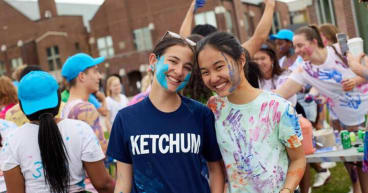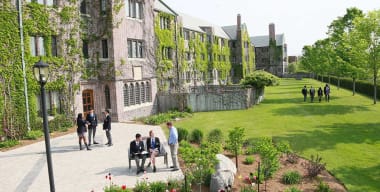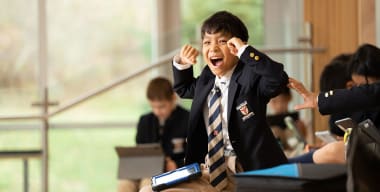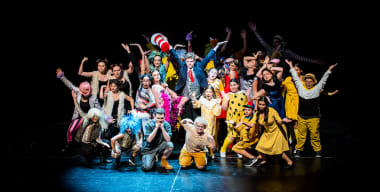Include digital literacy in your classroom
Our educational system has not had time to fully adapt to that tremendous change. There are so many questions we need to think about:
What does literacy mean today?
Our goal has always been to teach students to be literate. In the past, literacy included the ability to:
- Read and write
- Think in a linear, analytical pattern
- Understand basic cultural knowledge
In other words, being literate has meant being capable of thinking and communicating using the tools available at the time. In the 21st century, the meaning of literacy must expand to include the ability to use today's tools:
- Audio and video
- Laptop and tablet
- Camera and editing software
Introducing Microsoft Surface Devices for School
Help your child work naturally, stay focused, and achieve their best. Surface devices drive positive learning outcomes with touchscreen and inking, versatile form factors, and strong performance for every grade level.
Why You Should Use Service Devices:
- Achieve better learning outcomes. Intuitive, easy-to-use Surface devices help students to master the curriculum in any learning environment, physical or digital.
- Surface devices are as versatile as the students who use them. Your child will enjoy a safe, manageable environment from anywhere.
- Surface devices provide a personalized, engaging experience to every learner through multiple forms, including video, image, touch, and voice features that can adapt to every learner’s specific needs.
Shop now at the Our Kids Store by Microsoft
Does this mean throwing out what we have been teaching?
No. Students still must learn how to read and write; but they now have to learn how to read and how to express what they learn using modern media as well as using traditional forms. Students have to be able to create scripts and storyboards to use to make movies and podcasts; but they still must be able to write essays and stories.
Can modern and traditional media forms be combined?
Absolutely. The rules for writing don't change; an essay or a podcast still needs to establish a thesis, provide supporting evidence, and present a strong conclusion. A story must include plot and characterization whether it is presented as a short story, a movie, or a podcast. But a podcast can include images as well as words; teachers need to be able to teach students how to effectively combine words and images using information technology.
Isn't the software used to make modern media difficult to learn?
There are many types of software – and some, such as the video editing software used by professionals to edit Hollywood movies, is very complex.
But the software packages that can be used in the classroom were designed to be easy to use, and the resulting work is often close to professional quality. For teaching students writing, recording and editing skills, software such as iLife [Apple/Macintosh] and Windows Movie Maker are ideal. Best of all, these are free; iLife comes with every Macintosh computer, and Windows Movie Maker is a free download.
But isn't it difficult to use information technology in the classroom?
There are many challenges using IT in class, but they can be managed. If students have their own laptops [and many do], they already have all the tools they need. Students can work in teams of two or three with one computer. If necessary, much of the work [scriptwriting, storyboard drawing] can be done by hand, saving the computers for only actual recording and editing.
What role does the teacher play?
Teachers are already experts in teaching traditional literacy skills of reading and writing. Using IT means that teachers are still drawing on that expertise, but teaching students to express it with IT. Students are still writing, but the essay now takes the form of a script, and the final product the form of a podcast with images or a short movie.
Many teachers are intimidated by the thought of using IT itself, believing that they have to be experts in the use of the software before they can teach with it. Not so. Almost all of us use Word; how many of us use more than a tiny fraction of Word's capabilities? And despite all the talk of young people being digital natives, the vast majority of them are not; their knowledge, outside of gaming and Smartphone use, is a kilometer wide and a centimeter deep.
A teacher must understand two fundamental things:
- How to use and demonstrate the basic capabilities of the software
- How to use the Help function of any software
If the teacher doesn't know, the teacher and the student can find out. Today's teachers must be as much facilitators as fountains of knowledge. This will be more than enough information for students to be able to produce good work using the software.
What role does IT support play?
Teachers need help to introduce and use IT in the classroom. First, they need training; administrators must fully support their teachers with IT training if they want teacher to integrate IT in the classroom. Second, IT managers must be available to help teachers solve technical problems. Teachers must not be expected to become hardware experts and be able to solve issues with computers, networks or peripherals.
Literacy Evolves
The definition of literacy has always been evolving. Literacy originally meant the ability to read and write. In the 18th and 19th centuries, literacy included an understanding not only of reading and writing, but of the literature that formed the basis of the society's understanding of the world. In the 20th century, literacy expanded to include media literacy – how to understand and interpret the new media of motion pictures, radio, and television. But use of all these media types were generally restricted to the few who had access to printing presses, radio stations, or television and movie studios.
Today, literacy has become two-way for the first time. Not only can people receive information; they can respond to it and interact with it. A literate person in the 21st century must understand not only how to read, view, and interpret different media, but how to use media as well. The few voices of previous centuries have become a potential cacophony.
Our job as teachers is to ensure that our students are literate: that they can read, view, analyze, write and create using the media forms of our time. Like literacy, our tasks are ever-evolving; and like our predecessors, we will meet the challenge of the changing meaning of literacy.
Introducing Microsoft Surface Devices for School
Help your child work naturally, stay focused, and achieve their best. Surface devices drive positive learning outcomes with touchscreen and inking, versatile form factors, and strong performance for every grade level.
Why You Should Use Service Devices:
- Achieve better learning outcomes. Intuitive, easy-to-use Surface devices help students to master the curriculum in any learning environment, physical or digital.
- Surface devices are as versatile as the students who use them. Your child will enjoy a safe, manageable environment from anywhere.
- Surface devices provide a personalized, engaging experience to every learner through multiple forms, including video, image, touch, and voice features that can adapt to every learner’s specific needs.
Shop now at the Our Kids Store by Microsoft








